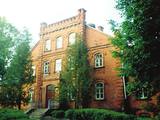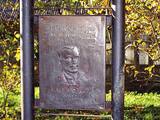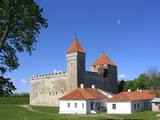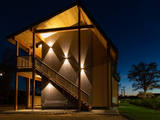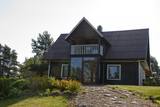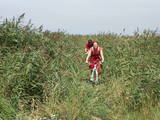| Nr | Nosaukums | Apraksts |
|---|---|---|
|
Samērā liela teritorija ar mozaīkveida ainavu - mežiem, atklātām ainavām un ezeriem (Salmejs, Kaučers, Stupānu ezers, Limanu ezers u.c.), kas atrodas Latgales augstienes Feimaņu pauguraines rietumdaļā. Aizsargājamo ainavu apvidus veidots šejienes dabas un kultūrainavas (apdzīvotās vietas, Tišas vecticībnieku lūgšanas nams, krucifiksi) un daudzveidīgo biotopu (t.sk. - sugu) aizsardzībai. Apvidū atrodas arī samērā populārs tūrisma objekts - Šnepstu pilskalns.
|
||
|
Atrodas 7 km uz ziemeļiem no Vecpiebalgas centra. Te apskatāmas 19. gs. Piebalgas lauku ainavai raksturīgas zemnieku un amatnieku sētas ar darbarīkiem un sadzīves priekšmetiem, kā arī nesen atjaunotās vējdzirnavas. „Vēveros” joprojām dzīvo arī daži vietējie cilvēki. Ieteicama muzeja apskate vietējā gida pavadībā!
|
||
|
Atrodas ceļa, kas ved uz Miķeļtorņa bāku – līkuma malā. Unikālā ēka (vienīgais lībiešu ciemu krogs ar raksturīgo plānojumu, kas saglabājies līdz mūsdienām) šobrīd atrodas avārijas stāvoklī un apskatāma tikai no ārpuses. Pizes krogs celts 1853. gadā. |
||
|
Rikavas muiža – valsts nozīmes vēstures piemineklis, sākotnēji
piederēja muižnieku Janovsku dzimtai. 18. gs. 2. pusē to nopirka poļu
muižnieks Mihals Riks. Muižas kungu māja celta no 1870. līdz 1875. gadam
neogotikas stilā no sarkaniem ķieģeļiem, kas iegūti Rikavā. Kopš
1926. gada tajā atrodas skola. Iekštelpās saglabājušās greznas koka
kāpnes un sākotnējo interjeru apdares fragmenti. Muižas pārvaldnieka
mājā iekārtota skolas darbnīca.
|
||
|
Dekšāru pagasta muzejs atvērts 1996. gadā. Ekspozīcijas par pagasta,
skolas un kolhozu dibināšanas vēsturi, par ievērojamu cilvēku
dzīvi, kas dzimuši vai darbojušies pagasta teritorijā. Latgales literatūras
kolekcija.
Darba laiks: P. - Piekt: 10.00 – 14.00, S., Sv : slēgts |
||
|
Mūra pils vēsture iesniedzas 13. gadsimtā. Pils pagraba zālēs ir izvietoti pastāvīgo ekspozīciju stendi, kas iepazīstina ar Sāmsalas dabu un vēsturi. No maija līdz augustam pilī ir atvērtas meistardarbnīcas (smēde, stiklinieku, keramikas, akmenskaļu darbnīca), kas mudina darboties pašiem. Te var šaut ar loku un izkalt monētas. No Sāmsalas muzeju filiālēm var apmeklēt Miķeļa lauku muzeju (Viki ciems, Kihelkonnas pagasts; +372 454 6613, www.saaremaamuuseum.ee) Sāmsalas rietumos. |
||
|
Mini zooloģiskais dārzs Brocēnu novadā, kur iespējams gan apskatīt, gan samīļot dažādus dzīvniekus lauku vidē. Sētā ir arī ugunskura vieta un nojume, kur patverties lietus laikā.
|
||
|
Ēku, kas uzbūvēta (1808. – 1810. g.) Doma kalna DA daļā, dēvē par Igaunijas zinātnes pērli. Observatorijā iekārtots atraktīvs muzejs. |
||
|
Bestes apartamenti ir jauna viesu māja, kas spēj vienlaicīgi uzņemt 45 viesus (+10papildvietas). Viesu nams būvēts un veidots latviskā stilā (koka ēka, kas galavota tepat Mūrmuižā), izmantotas Latvijā ražotas gultas (Nakts mēbeļu meitas uzņēmums), Latvijā ražota gultasveļa (Mežroze) utt. |
||
|
Ciemos gaidīti gan pāri, gan ģimenes, gan draugu kompānijas. Lauku sēta sastāv no piecām ēkām. Neskartā daba un tīrais gaiss ļaus atpūsties pilnīgā klusumā. Ap 50 m no Šventosios (Svētās) upes atrodas galvenā ēka, kurā ir divas guļamistabas ar tualeti un dušu nakšņošanai līdz 10 personām. Pirts namiņš būs ērts draugu lokam līdz 9 cilvēkiem. Pieejami trīs jauni VIP namiņi 2-4 cilvēkiem upes krastā. Piemērota vieta kāzu, dzimšanas dienu u.c. svinībām. |
||
|
Seklais un aizaugošais (aizaugums ap 40 %) Liepājas ezers ir viens no nozīmīgākajiem Baltijas jūras piekrastes ligzdojošo un migrējošo putnu (atpūtas, barošanās vieta) ezeriem, kurā konstatētas > 100 putnu sugas. Tas ir arī ne mazāk nozīmīga daudzu iesāļiem biotopiem raksturīgu augu sugu dzīves vieta. Liepājas ezera ziemeļaustrumu krastā – Vītiņu pļavās palieņu pļavu apsaimniekošanas nolūkos ir izlaisti dzīvei savvaļā pielāgotie mājlopi, izveidots skatu tornis, kas pieejams iepriekš piesakoties gida pavadībā. Interesantus skatu punktus un ainavas, kā arī ceļojuma iespaidus var gūt, izstaigājot vai ar velosipēdu izbraukājot (ekstrēmi, sevišķi vasarā!) dambju sistēmu, kas atrodas ezera dienvidrietumu daļā. Ezera apkārtnē atrodas unikālās Liepājas fortifikācijas sistēmas atliekas. |
||
|
Restorāns "Olīve" atrodas Liepājas dienviddaļā. Restorānam ir „atvērta” tipa virtuve, kur klienti var vērot pavāru darbošanos. Latviešu virtuve: baraviku zupa, zivju zupa, plānas un kartupeļu pankūkas, jēra karbonāde, grillēta cūkgaļas fileja, tvaicēta teļa mēle, jēra stilbiņš, biezpiena kārtojums. Īpašais ēdiens: mencu zupa „Olīves” gaumē vai īpašā saldējuma kūka. |
||
|
Atrodas Jelgavas–Emburgas–Bauskas ceļa malā, tāda paša nosaukuma apdzīvotā vietā, Lielupes labajā krastā. 1924. g. šeit mājas celtniecību uzsāka Jānis Čakste (1859 – 1927) – pirmais Latvijas Valsts prezidents (1922. – 1927.). 1999. g., kad J. Čakstem apritēja 140. dzimšanas diena, Aučos atklāja ekspozīciju par prezidenta dzīvi, darbību un Čakstes dzimtu. Te apskatāms J. Čakstes kabinets, bet izstāžu zālē – Jelgavas mākslinieku darbi. |
||
|
Vienīgo skolas botānisko dārzu Lietuvā sāka iekopt 1989. gadā Traupja skolā. Visas augu kolekcijas (kopumā Traupja botāniskajā dārzā aug jau vairāk nekā 8000 augu sugu, formu un šķirņu) ir savācis viens cilvēks – S. Obelevičus. |
||
|
Pirms Turaidas mūra pils celtniecības (to uzsāka 1214. g.) tās vietā atradās lībiešu no koka celtā pils. Turaidas pils piederēja Rīgas bīskapam. Tā pastāvēja ilgu laiku - līdz pat 1776. g., kad pils nodega. Pils galvenajā tornī sākotnējā ieeja atradās 9 m augstumā, tādēļ 1936. g. izveidoja izlauzumu torņa pirmajā stāvā un iekārtoja skatu laukumu 27 m augstumā. Otra tāda skata, kāds paveras no Turaidas pils, Latvijā vairs neatrast! 1953. g. Turaidas pilī uzsāka restaurācijas darbus - atjaunoja torņa augšējo stāvu un uzcēla jumtu. Atjaunoja arī bijušo klēts ēku (arhitekts G. Zirnis), kur izvietoja ekspozīciju par Siguldas novadu, pusapaļo torni (arhitekts G. Jansons) un pils kompleksa dienvidu korpusu ar vēsturiskā interjera rekonstrukciju. No 1976. – 2001. g. pils apkārtnē noritēja arheoloģiskie izrakumi, kā rezultātā lielu pils kompleksa daļu atjaunoja. Pils telpās izveidota muzeja ekspozīcija par apkārtnes vēsturiskajiem notikumiem. Turaidas pils ietilpst Turaidas muzejrezervāta teritorijā (aprakstu sk. iepriekš pie Nr. 18.) |
||
|
Braucot cauri Kaives ciemam, var pievērst uzmanību Kaives muižas „atliekām”. Vietas vēsture ir sena, jo jau 1440. gadā Livonijas ordeņa mestrs piešķīra šeit īpašumu Johanam Kaivenam. Kungu māja gāja bojā 1905. gadā, bet pārvaldnieka ēku nopostīja 2. pasaules kara laikā. 1956. g. nodega kalte, bet pirms trijām desmitgadēm - muižas krogs. Līdz mūsdienām palikusi tikai 1861. gadā celtā magazīna (sarkana ķieģeļu ēka) pakalnā un tai blakus esošais parks, kurā izveidots neliels skulptūru dārzs, estrāde un atpūtas vieta. |
||
|
Arbūzu audzēšanu saimnieki uzsāka 1997. g., izmantojot šķirnes, kas piemērotas Latvijas klimatiskajiem apstākļiem. Saimniecības „odziņa” ir arbūzi ar dzelteno mīkstumu. Lielākais izaudzētais arbūzs svēris 11 kg. Sezonas laikā – arbūzu iegāde un saimnieka padomi. |
||
|
Krodziņš „Četri vēji” atrodas Rīgas - Liepājas autoceļa (A9) 72. km. Krodziņā tiek piedāvāti dzīvās mūzikas vakari. Latviešu virtuve: Vidzemes salāti, siļķe ar biezpienu un krējumu, pelēkie zirņi ar speķi, sautēti kāposti ar desiņām, kāpostu tīteņi, kartupeļu pankūkas, maizes zupa, rupjmaizes kārtojums. Īpašais ēdiens: „4 vēji” – cūkgaļa ar štovētiem kāpostiem un kartupeļiem uz karstas pannas. |
||
|
Interesanta dažāda vecuma ēku ieskauta gājēju ieliņa (gājēju daļa ~ puskilometrs), kura var novērot pilsētas arhitektūras stilu attīstību no 17. - 20. gs. Šeit tāpat kā citur Kuldīgā var apskatīt un nofotografēt pilsētai raksturīgos virsgaismas lodziņus un greznās un daudzveidīgās ēku durvis. Te vērts pasēdēt arī krodziņā! |
||
|
Restorāns atrodas Abavas upes krastā, Pūrē, blakus Šokolādes muzejam. Te sastopama mierpilna atmosfēra, lai katrs klients gūtu sev jaunas emocijas caur garšu pasauli ar tās neizmērojamām iespējām. Restorānā pieejama arī plaša vīnu izvēle. |
||



